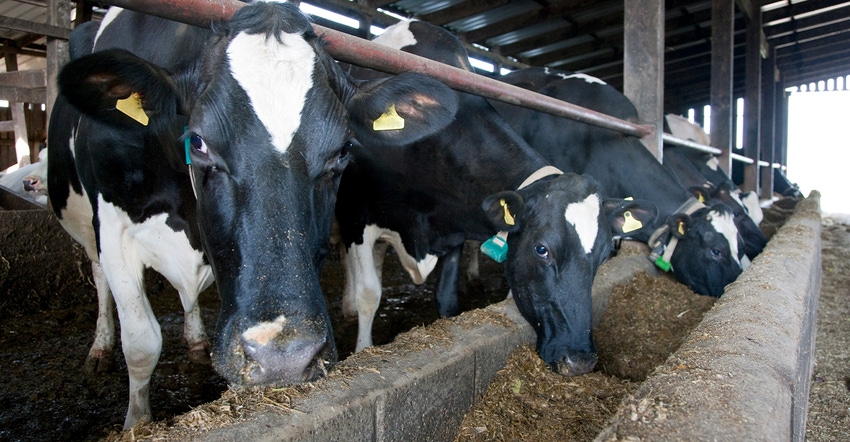
The good news is milk prices are continuing to improve.
“The Class III price, which was as low as $13.89 in February, will improve about $2.40 in June to around $16.30,” says Bob Cropp, University of Wisconsin-Madison dairy economist. Much lower milk production is the driver for improved prices, he notes. For the U.S. compared to a year earlier, April’s milk production was up just 0.3%, with May down 0.4%.
Cow numbers in May were 9.33 million head, down 89,000 since January and 0.9% lower than a year ago. The continued exit of dairy producers and cow slaughter running 5 % higher than a year ago is reducing the size of the dairy herd. Milk per cow was also well below trend, up just 0.6%. Of the 24 reporting states, 14 had fewer cows and 11 had lower total milk production.
Lower milk production leads to lower dairy product production. Compared to a year earlier, April butter production was 4.8% lower. American cheese production declined 2.8%, and cheddar was 3.3% lower, with total cheese production just 0.2% higher. Nonfat dry milk production dropped 2.6%, and dry whey production declined 13.7%.
Meanwhile, butter and cheese sales continue to show modest growth. But fluid milk sales continue their downward trend, with April sales 3.1% lower than a year ago and year-to-date sales down 2.5%.
While lower than a year ago, dairy exports are supportive of milk prices.
“With lower milk production, exports do not need to be as high to support milk prices,” Cropp says. “For the first four months of the year, exports on a volume basis were the third highest, with 2018 being the highest and 2014 the second highest.”
Much lower exports to China are the major factor for reduced volume of exports. China’s retaliatory tariffs and the African swine fever resulted in April exports to that country being 64% lower than a year ago. Cheese exports have held up. While April cheese exports were 1% lower than a year ago, year-to-date exports are 7% higher.
April exports were down 25% for nonfat dry milk/skim milk power, 71% for butterfat and 31% for total whey products. Yet on a total solids basis, exports were equivalent to 14.4% of U.S. milk production.
The level of dairy products stocks is also improving. Compared to the year before, April 30 stocks were 5.4% lower for butter, 0.3% higher for American cheese and 4% higher for total cheese. However, dry whey stocks and nonfat dry milk stocks were 8.9% and 1.6% higher, respectively.
“Milk prices should improve further as we progress through the rest of the year,” Cropp predicts. USDA now forecasts milk production for the year to be 0.3% higher than 2018, the result of cow numbers averaging 0.7% lower and milk per cow 1% higher.
Higher feed prices
It looks like feed prices are increasing. Alfalfa hay prices will be higher. Current hay stocks are tight, and there are reports of significant winterkill in Wisconsin and other states. Harvesting quality first-crop hay was also challenging due to wet weather.
“Delayed corn planting and unplanted acres means higher corn prices,” Cropp says. “Tighter feed supplies, lower-quality forages along with higher feed prices will likely continue to reduce cow numbers and dampen milk per cow this fall and winter.”
Butter and cheese sales are expected to continue to show modest growth, he notes. While exports will be lower, they will still support milk prices.
“It doesn’t look like the trade dispute with China will end soon,” Cropp says. “In May, the U.S. increased tariffs on China’s goods, and China, in turn, increased tariffs levied on U.S. dairy products. But in May, the U.S. eliminated tariffs on steel and aluminum from Mexico, and Mexico, in turn, eliminated its tariffs on U.S. cheese. This could be positive for cheese exports later this year and going into 2020.”
As of now, we could see the Class III price in the low $17s by August and in the mid- to high $17s by fourth quarter, with some predicting Class III prices will top out in the $18s.
“If this holds true, Class III would average about $16.30 for the year compared to $14.61 in 2018,” Cropp concludes.
About the Author(s)
You May Also Like






